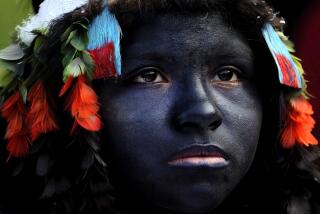A Cultural Island on Taiwan
WULAI, Taiwan — In a valley of pristine bamboo and cypress trees, Yasa T’iehmu painstakingly adds tufts of red and yellow flowers to his painting of a slender, nude aboriginal woman.
The woman has long black hair reminiscent of the surging waterfall in the background.
“That’s a fellow tribal woman I once saw taking a hot-spring bath,” Yasa says, leaning over a simple wooden table outside his red tin-roofed home in Wulai, a village about 12 miles southwest of the Taipei suburb of Xindian.
Wulai sits in the towering Fushan Mountain Range, seat of the Taiya tribe, one of 11 aboriginal groups whose 430,000 members make up a little less than 2% of the 23 million people living on this economically booming island. There are about 60,000 Taiya.
Anthropologists say the aboriginals’ ancestors came to Taiwan from nearby Pacific islands some 6,000 years ago. Other groups -- mostly Han Chinese -- began migrating from the Asian mainland about four centuries ago, but the aboriginals kept to themselves, hunting and subsistence farming up and down Taiwan’s 240-mile mountainous spine.
In recent years, however, as more and more of their people have assimilated into Taiwan’s urban society, the aboriginals have been fighting a losing battle to maintain a separate cultural identity.
It is a phenomenon that Yasa has dedicated his art to reversing.
“I draw from memories,” he says, leafing through his rich paintings of tribal people farming, weaving, fishing and courting under a tropical moonlit sky.
“Our children barely speak the Taiya language. They look at my pictures and exclaim, ‘This was how we aboriginals looked in the old days.’ ”
Yasa is not alone in seeking to preserve Taiya traditions.
Deeper in the mountains, T’iehmu A’yung and dozens of his neighbors are determined to keep tranquil Fushan Village isolated from the influences of a tourism center set up a dozen miles away for visitors who want a look at aboriginal lifestyles.
Outwardly, however, the aboriginals aren’t that different anymore.
Their bamboo and wooden houses have mostly been replaced by concrete structures equipped with basic modern amenities, although the homes retain traditional slanting roofs to sluice away the frequent downpours.
Face-tattooing was once a symbol of aboriginal adulthood, but it has been given up as a remnant of a barbarous past. Many aboriginals reserve their colorful traditional clothes and elaborate headgear for tribal festivals that feature days of dancing and singing.
Wulai itself has become a gaudy collection of cheap souvenir shops and uninspiring restaurants catering to tourists from Taipei.
But tourism is a boon for the Taiya, giving them much-needed work as tour-bus drivers and small-scale retailers -- reason enough to stay home.
T’iehmu, 46, a small, sturdy man, takes hikers on daylong treks up and down narrow mountain trails. To supply the small restaurant run by his wife, he raises vegetables, traps wild boars and chops logs for growing delectable wild mushrooms.
He says his three brothers have already moved away from the village. He fears his two young children might be tempted to follow them to the bright lights of Taipei.
In another part of the village, Kao Chiu-mei is hard at work at the Fumiyo workshop, started with 10 other women to preserve the ancient tradition of weaving floral motifs and other patterns on white linen.
She says she originally learned the craft from her elderly mother and is committed to ensuring it is passed along to future generations.
Still, with many tribal people attracted by the relatively easy life in Taipei and other Taiwanese cities, the battle may soon be lost.
“Life is difficult here even if we do have a great natural environment,” says Lin Chao-hui, a town official in Wulai.
More to Read
Sign up for Essential California
The most important California stories and recommendations in your inbox every morning.
You may occasionally receive promotional content from the Los Angeles Times.










